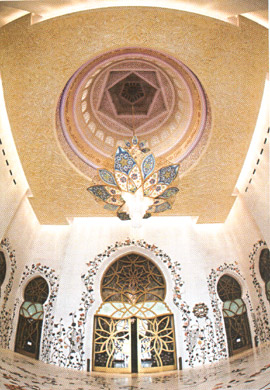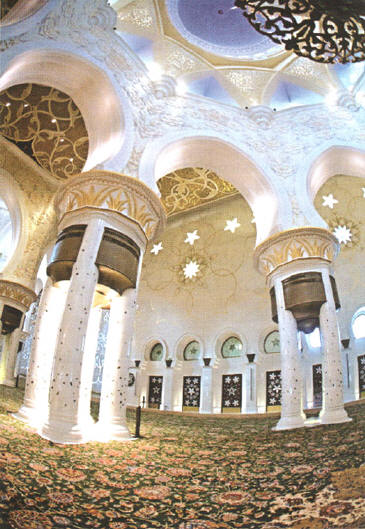|
Built on a 9.5-metre high hill that makes it visible from far,
covering an area of 22,000 square metres, and with the capacity
to accommodate more than 40,000 worshippers, the Shaikh Zayed
Grand Mosque in Abu Dhabi is an architectural masterpiece,
dedicated to the late Shaikh Zayed bin Sultan Al Nahyan, fondly
remembered as the Father of the UAE.
Completed in 12 years at an estimated cost of Dh2.167 billion,
it is the third biggest mosque in the world after Islam’s two
holiest sites in Saudi Arabia – Mecca’s Grand Mosque and the
Prophet’s Mosque in Medina.
With its 82 domes decorated in white marble and white gypsum
adorning the mosque’s interior, the Zayed Mosque has earned the
sobriquet, the ‘white pearl of the Gulf’. The mosque has four
minarets on four corners with a height of about 107 metres each.
The very best of coloured floral marble and mosaics have been
used to pave the courtyard which is about 17,000 square metres.
While the mosque’s architecture combines the best of traditional
Islamic designs and modern architectural techniques, what is
drawing crowds to this holy place of worship is the sense of
peace and utter serenity that it invokes.
  |
The work on the mosque was initiated by the late ruler, founder
and first president of the UAE whose vision was founded on
dialogue between religions, civilisations and cultures. In the
true spirit of this vision, the Sheikh Zayed Bin Sultan Al
Nahyan Mosque, popularly called Grand Mosque by local residents,
is seen as a ‘globally unifying’ landmark from its conception to
completion, bringing together designers, features, materials and
suppliers from nearly every corner of the globe - Italy,
Germany, Morocco, India, Turkey, Iran, China, Greece and the UAE.

In terms of grandeur, size and style, the Shaikh Zayed Mosque in
Abu Dhabi is a true wonder to behold. The design and location of
the mosque was chosen by late Shaikh Zayed himself as he wanted
it to be in the middle of Abu Dhabi. This majestic Mosque is the
most imposing religious and national landmark in Abu Dhabi to
date and is also arguably one of the most important
architectural treasures of the contemporary UAE society.
However, this newly opened architectural masterpiece has also
received greater attention for achieving three entries into the
Guinness Book of World Records as it features the largest carpet
in the world, the biggest chandelier and the largest dome of its
kind in the world.
  |
The main dome's outer shell is 32.8 metres in diameter and
stands at a height of 70 metres from the inside and 85 metres
from the outside. It is the largest of its kind in the world,
according to Turkey's Research Centre for Islamic History and
Culture.
Seven copper and 24-carat gold-plated chandeliers, imported from
Germany at a cost of about Dh30 million, are fixed inside the
mosque. The largest chandelier is 10-metres in diameter and has
a height of 15 metres. It is the biggest chandelier in the
world, and incorporates one million Swarovsky crystals.
However, for sheer beauty and exemplary workmanship, none can
compare to the world’s largest hand-woven Persian carpet that
graces the main prayer hall of the Grand Mosque. Covering an
area of 5,700 square metres, more than 1,200 handpicked carpet
weavers, 20 technicians, 30 designers, dyers and other skilled
experts had been involved in weaving the four-piece rug which
took a total of 21 months to complete at an estimated cost of
US$8.5 million.
The production of the world’s largest handmade rug began in
January 2006 by the Iran Carpet Company (ICC). The design work
took six months, the weaving a year and the finishing work a
further three months.
Custom-made for the Sheikh Zayed bin Sultan Al-Nahyan mosque by
the ICC, this large hand-made masterpiece has a unique design,
featuring five big medallions depicting various traditional
flower motifs. About 30 tons of wool and 15 tons of cotton were
used in weaving the mammoth rug in the size 135x46 metres. Its
green background features a variety of 25 naturally dyed yarns.

Designed by Iranian artist Ali Khaliqi, the carpet was woven by
1,200 artisans in Mashhad in Iran, a region renowned for its
carpet-making expertise. The rug, produced by handpicked
weavers, has 2.2 billion knots.
The carpet is made of wool and cotton in 25 different colours.
No silk has been used. Fifty per cent of the wool came from Iran
and the other 50 per cent from New Zealand. The weavers used
pure natural wool from the Sistan and Baluchestan and Hormuzgan
provinces, which are famous for their fine wool produced by
nomads. As for cotton, only pure Iranian cotton was used. The 25
colours include 20 natural dyes and five fast synthetic colours.
The rug was assembled by weavers at three large workshops in
three different villages in Nishapur near Meshhad, the capital
of the province of North Khorasan. The province – particularly
Meshhad and its remote areas – is the centre of production of
the famous Meshhadi, Balochi and Torkmen rugs.
The mosque rug’s design features Islamic and traditional Iranian
floral art and motifs.
The carpet pieces were flown to Abu Dhabi in two airplanes along
with artisans to hand-stitch the pieces together for the final
fitting. It cost Dh30 million.
|